This article is meant to provide an alternative to Brett Jones’ excellent SFG I prep guide and for building strength and endurance for the SFG II. Brett’s plan has worked for many people, but individual differences might lead some people to benefit from an alternative. This program might be more like Easy Strength where you leave the gym feeling like you have reps left over. Due to this feeling, you might put more crispness and power into the reps you do.
This plan is built on Pavel’s recent developments in strength protocols, where he examined the Soviet literature on the successful weightlifting program of the 1990s. It is also based on his recent research in conditioning protocols that focus on lasting endurance without the stressful cortisol response associated with high intensity training. This preparatory program consists of three days of conditioning and three days of strength training.
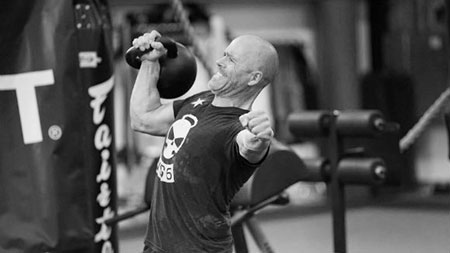
Steps 1 and 2: Knowing the Standards and Getting Help
There is no need for me to change what works. Brett Jones, StrongFirst’s Director of Education, describes the first two steps in preparing for your Certification experience as:
- Knowing the standards
- Contacting a certified instructor
I agree and strongly advise finding someone who knows the SFG Level I and/or SFG Level II movements. An instructor can help you learn how to be efficient in your movements, which will save you energy. There is no reason to pattern bad movements, as they will only become more difficult to change later.
I also recommend taking videos of your training practice. I am often surprised when I watch my movements, and these revelations help me tweak my patterns. Many instructors will review videos, so even if you don’t have a StrongFirst instructor in your area, you still have many options for acquiring feedback on your movement patterns.
Recommended Warm-up
Get-ups are an excellent warm-up exercise that can build itself as a skill. Start with one set of no-weight get-ups on each side. Then do two to three sets with a moderate amount of weight. Don’t feel you have to use your snatch-size kettlebell on every set of get-ups. Using light weight (or no weight) can be a great corrective experience. It is a good idea to watch your form on video.
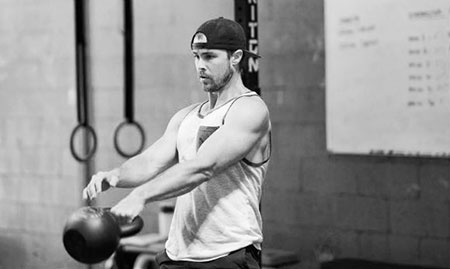
Understanding Our Objective and Your Energy Systems
Having a proper swing is going to be key to your success in the snatch test. The more power you have in your one-handed swing, the easier it will to achieve the efficiency required to perform 100 snatches in five minutes. Thus, the bulk of this program will be on building powerful one-handed swings.
To do this, we want to build more mitochondria and to make them more efficient. Mitochondria produce the ATP that our muscles use to contract. We can think of ATP as our muscle’s currency. The more currency we have, the more we can spend for strength endurance and absolute strength. Thus, this conditioning program will likely benefit your strength, as well.
Scientists often describe three energy systems that create ATP—the alactic, glycolytic, and aerobic systems:
Alactic System
This is the system that supplies quick, intense bursts of energy. It runs out quickly. You primarily tap into this system during sprints or heavy lifting. It is also referred to as the anaerobic (without oxygen) system. Without getting into details, it relies on your storage of ATP and creatine phosphate. Your mitochondria use the phosphate molecules of creatine phosphate to create additional adenosine tri-phosphate (ATP). Taking creatine as a supplement helps this system, but your body can only store so much. The program below will make this system as efficient as possible so you can lift heavier weights.
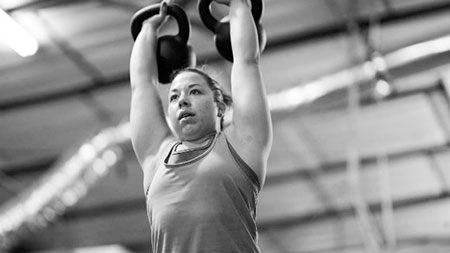
Glycolytic System
This is the in-between system; both anaerobic and aerobic. It is utilized most when you try to sprint for longer than twenty seconds, do more than fifteen reps of an exercise, or complete a twenty-minute high-intensity workout. Many fitness programs live in this high-intensity burn. Training here can be very addictive and it makes you feel like you have “worked out.”
It might seem counterintuitive, but we want to avoid “the burn.” Training in this system puts a good deal of stress on the body. Although it might be good in the short-term (high intensity programs tend to work well at the beginning), the stress leads to long-term oxidative damage and might impair our mitochondria’s efficiency. We only want to use this system sparingly as we get closer to the snatch test.
Additionally, this system relies on glucose to create creatine phosphate molecules. You want your body to learn to burn fat for fuel. High-intensity programs can lead craving excess sugar as your body is using so much of it for energy. It is another reason to avoid using this system as much as possible during your preparation.
Aerobic System
This system allows for long and slow bouts of energy, and it relies primarily on fat sources for fuel. It is highly efficient, but low in power. The program below will utilize this system to burn fat, build peak endurance, and help the body rely less on the glycolytic system during competition. We basically want to increase the capacity of our alactic and aerobic systems and shrink our use of the glycolytic system.
The Conditioning Program
We may have been told that we must “endure” during our endurance training. However, your goal with this program is to feel powerful after your training. You will push yourself (use your alactic system), back off (replenish it with the aerobic system), and then do it again. Think of it as doing short sprints followed by rest.
We will use the one-handed swing during this training. It will help you build a powerful hip snap that will be very valuable during the snatch test. You will only work for ten to fifteen seconds of each minute, so you will want to make the swings as powerful as possible. Imagine that these ten swings are going to be judged for how good they look. You could also visualize Brandon Hetzler testing your force output (like he did with Pavel in the photos below). Each round should be a quest for the perfect and most powerful swings. (This is a place where video can be helpful.)
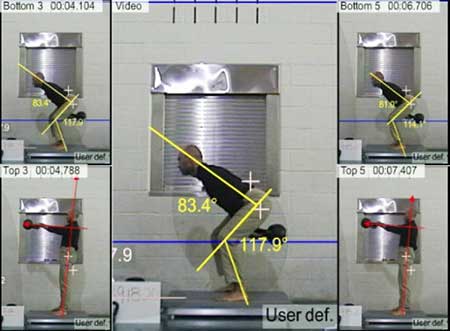
Here is the program outline (much of this is also based on Al Ciampa’s excellent A+A program):
- Perform 10 one-handed kettlebell swings every minute on the minute (left one minute, right the next). If your form is not quite up-to-par (e.g., too much twisting), then two-handed heavy swings are also acceptable.
- Use your snatch-size kettlebell or heavier.
- Train 3 days a week for 6 weeks.
- Make one day longer than the other two (e.g., Monday: 10 minutes, Wednesday: 14 minutes, Friday: 12 minutes).
- Each week, try to add two minutes to the length of each session (do not go over 30 minutes).
- Use the talk test to make sure your rest period is long enough. If you can talk comfortably before beginning the next set, then you are okay. If you are too out of breath to talk, then you need to add more rest in between sets.
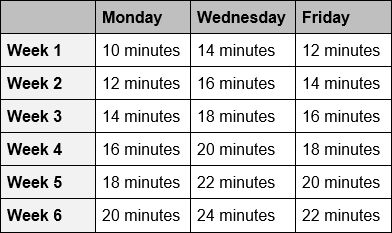
Once your workouts have reached thirty minutes, you can start over with a heavier kettlebell or by doing twelve or fourteen reps per minute. Moving to a heavier kettlebell is the preferable approach. Either way, the same rules apply—make sure you can still perform the talk test before starting the next round in each workout.
The Strength Plan
The goal of this program is to build enough strength to handle many presses over the Certification weekend. It could also be used to increase your one-rep max (1RM). This goal will be even more important if you are using this plan as SFG II prep.
The foundation of this program is based on Pavel’s Plan Strong™ principles. Russ Dunning and Fabio Zonin successfully used this protocol to train multiple athletes to press the SFG II standard of a half-bodyweight kettlebell press. I find this style of program allows me to train athletes consistently over long periods of time without having to take rest weeks.
That said, there are a couple keys to success with this program:
Don’t Train Heavy All the Time
Soviet Olympic weightlifting athletes did not often attempt 1RM in their training. Most of their training was done with 65-85% of their 1RM. This method is contrasted with the Bulgarian-style training systems, which rely on much heavier weights in training.
The Bulgarians were also successful in Olympic lifting; however, their athletes were not known for their long-term durability. Many of the Soviet lifters broke Olympic records long into their thirties. Leonid Taranenko won his first Olympic medal in 1980 and his last in 1992 at the age of 36. Taranenko’s combined total in 1988 for the snatch and clean and jerk was 475kg (1,047lb), and remains the heaviest ever lifted in a competition.
The key is to ensure you can continually press by not taxing the nervous system too much.
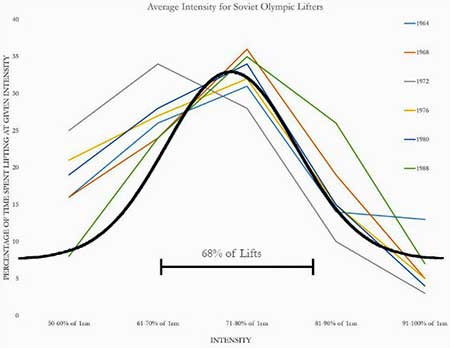
Decouple Volume and Intensity
We often see a pattern in Western programs. Most start off with more reps at lower weights, and progress toward weeks with a few lifts at heavier weights. These programs are called linear because you add weight each week. A simple example is Wendler’s 5-3-1 program. In the first week, the person lifts 5 reps at around 75% of his or her 1RM. By the third week, the person is lifting one rep at 85-90% of his or her 1RM.
In contrast, the Soviets decoupled volume and intensity. One week might be high volume and high intensity and the next week would be low intensity and medium volume.
Waving the volume and intensity allows for more natural recovery and greater strength gains.
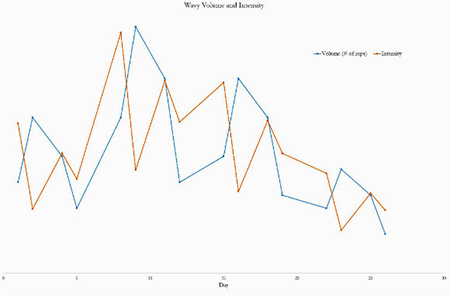
The Strength Program
This kettlebell press program can be done on days when you are not performing endurance work. There will be some days that seem too simple (e.g., week 3, day 1) and some days that are not so easy (e.g., week 2, day 3). Stick to the program. Do not add weight nor reps because you feel better that day.
The chart below provides values and reps for each day. For example, if your kettlebell press 1RM is 100lb, then you only need three weights: 75lb, 85lb, and 90lb. Please don’t worry if you don’t have the exact weights. A 32kg (72lb), 36kg (80lb), and 40kg (88lb) could easily be substituted. For people using lighter kettlebells it becomes a bit more challenging as the jump in weights leads to bigger jumps in percentages. You might need to get some smaller graduations in kettlebell weights.
Start with a lighter weight to warm up. You shouldn’t start at 75% of your 1RM. Some people need a good deal of warm-up and others need very little. You are on your own to figure out what works best.
Rest periods between sets should be greater than ninety seconds as you want to have as much power as possible on each set. You might take up to eight minutes before trying your 90% weights.
Setting up a video recording can be useful here, as well. You want your reps to look easy and strong. You’ll have a clearer picture of technique watching yourself back on video than you will in the moment.
Notes on reading the chart: Take the percentage listed and do that much of your 1RM for the number of reps indicated. A comma between number means multiple sets with the weight. For example, on day 2 of week 1, you would do:
- Two sets of 2 with 75%
- Three sets of 2 with 85%
- Two sets of 2 with 75%
This program can be used repeatedly by adjusting for your new 1RM after each cycle.
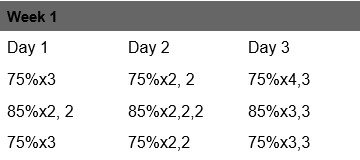


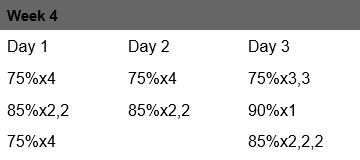
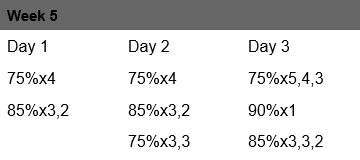
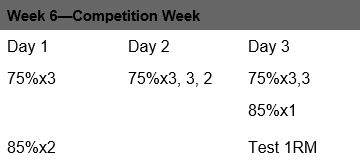
Supplemental Training
It is also important for you to work on your kettlebell skills, mobility, and coaching technique outside of this program. Finding a StrongFirst Certified instructor might be your best option for improving your skills. Mobility work is always important if you do not have the prerequisite mobility for squatting. An FMS/SFMA screen might help identify specific mobility/stability problems in your movements.
Summary: A Science-Based Plan
This alternative preparatory guide for the SFG Level I and/or SFG Level II is meant to build your conditioning and strength using Pavel’s latest research. It is based on extensive testing by Soviet researchers and by our current research. Pavel is known for making the complicated simple and his culling of the strength and endurance research has made our current research possible.
For some athletes, this program will be all they need. I have trainees who described feeling more powerful snatches and enough aerobic conditioning to breeze through the snatch test after following this program. For others, a bit of glycolytic training can also be helpful. StrongFirst Certified Senior Instructor Mike Perry, who trains many MMA fighters, often adds glycolytic training closer to competition. He believes it is good for his fighters to understand how “the burn” feels as they will inevitably feel it during a fight.
With enough time, the above program will build plenty of strength and endurance. For those needing to cram a bit more, glycolytic training in the last two months of training might be helpful. Mike Perry’s snatch test plan is an excellent one that can be used closer to the competition.
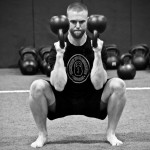

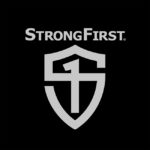
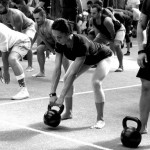


Just so I’m clear, this is a six day a week program alternating swing and press days? Similar to the original Program Minimum.
If I can hit the Simple standard for swings (with the 32), would it be easy to do the snatch test with the 24?
nope. it will make it easier but you need really good snatch technique. S&S style swings with 5-10 snatches after is a good way to practice the snatch maybe sub one swing session in for snatches
I’m curious about the reason for not going over the 30 min mark.
Hi Graig,
I want to start the conditioning part of the program.
My goals are the Simple goals but now I am stack, for a while now, with the 32k 1H swing; I have hard times to go below 8’30” without loosing form or crispness.
So I decided to start this program with the 28k.
You said to follow the program for six weeks but even to not go over 30 minutes, that’s 9 weeks.
Do I have to do it for six week, rest a week and go until 30 minutes?
Or do I have to stop at 24 mins (6 weeks)?
Thanks, marco
Test
Hopping into this program this week and wanted to confirm: with the single-arm swings, for minute one, you only do 10 swings on the left, rest, then for minute two, 10 swings on the right, rest, minute three, 10 swings on the left, etc? Not 10/10 for minute one, 10/10 for minute two, etc?
Thank you!
Finished one six week cycle of this program.
For swings I used 24k KB.
For strength part I did weighted pull-ups. My 1RM was BW + 30k.
After finishing this cycle, I feel stronger and more conditioned.
I did 100 swings with 24k KB in 3.02 (3 minutes, 2 seconds) and that is my PR.
I tested my 1RM pull-up and it is BW+32k. Also tried +35k but it was failure.
General opinion:
– as mentioned before – great article and great program
– it does not wear you so you have Energy for other daily activities (I am 40 yo police officer and father of three kids)
– you gain conditioning very fast; strength gains ar slower but I gains are steady
Concluison: program works and is well suited for bussy people with little time and also for master trainees
Also, thank to the Author for detailed explanation.
Thanks Hogar for the kind comments.
Could this be done with an upper and lower body lift at the same time? Or best to just work on one main lift?
I started to follow this program 4 weeks ago. So far I can say this this is an excelent article and program.
I feel I get stronger and more conditioned but I am not burning out.
I am doing this with 24kg kb for swings and for the strength part I am doing pull-ups where starting point was1 RM o BW+30kg.
After I complete 6 weeks I will post my results in details.
Dear Craig,
May i ask some questions pertaining to the strength program.
Why does the reps drop in say for eg (85% for 3 3 2 onstead of say just straight sets ahead for same number of reps)?
I just am curious and want to learn the reasons behind it.
Myren,
There is some flexibility on how you do your sets. I like to get the more difficult ones done first, so I set it up that way. You can switch it to 3, 2, 3 as a good alternative as well.
Craig, do you suggest resting between the L and R arm or simply doing the L and R arms without putting the bell down?
Craig,
your presented program looks great. I have two questions regarding the conditioning part:
The foreseen volume of swings is significantly lower than in Al Ciampa’s A+A program that you have been referring to. In your experience does the decreased volume (in terms of days per week and sets per training) make a huge different in development of endurance?
I’m currently looking for a conditioning program that I intend to use for my snatch test preparation. I would probably focus on conditioning and not follow the strength program; as you wrote the pressing part is predominantly required for the SFG II certification. Under these circumstances would you recommend following your condtitioning program or Al Ciampa’s program?
Thanks,
Martin
I wanted to let you all know that I took your strength template and put it into an excel spreadsheet so that all you need to do is enter your max and it’ll figure out the rest for you. It’ll even figure out how much to put on each side of the bar. Grab it here if you want it.
https://thenaturaladvantage.wordpress.com/2016/12/15/strongfirst-com-training-program-template/
I’m looking for something simple to start the new year with, but currently I don’t think I could accomplish this with a snatch bell on the minute.
Would you recommend decreasing bell weight, increasing rest time (keeping the sets or total time constant?), or decreasing reps? Or something else?
A probably less smart question:
Craig, are you talking about single KB press or about double KB press?
Good question. I leave it up to you.
For most people, I would do the number listed with each arm individually.
I do double kettlebell presses to train out any lean I might have.
Can the strength program be applied to other exercises? Especially dips and pullups? If yes, can both exercises be done in a slow circuit or is the program strictly designed for one exercise only?
It can be done with other strength exercises. I applied it to the press as it is important for certification. The one trick for bodyweight exercises is to make sure you calculate your 1RM properly. Thus, if your 1rep max for the pull-up is 48kg, you would need to add that to your bodyweight (e.g., 48kg kettlebell + 90kg bodyweight = 138kg; your 80% weight would be 110kg or 90kg bodyweight + 20kg kettlebell).
This seems like a variation on Daily Undulating Periodization (DUP)?
Also forgot to ask.
Would you do this as a 6 day routine?
IE – Swings M-W-F, Press T,Th,Sat ?
Sun rest and beer?
“This preparatory program consists of three days of conditioning and three days of strength training.”
That is the way I would take it.
6 days works great. If you can do two a days, you can do the conditioning in the morning and the strength later.
Wow. This is great and also kinda strange that I myself am on a swing journey that is laid out very similar (based on all of my years with Pavels stuff and going through the SFG course)!
Awesome.
Craig, in your experience is there enough pressing volume in the strength program to make steady progress up to the half body weight press? It seems to be a fair bit less than in ROP or some other programs.
Great question David. Pavel suggested 200-300 reps per month above 70% of your one rep max. This plan is on the lower end of that. You can do more reps, but it would be best to be below 70% of your one rep max.